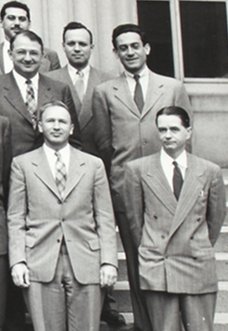PAOC Spotlights
The Office Next Door
Casual conversations among colleagues can prove surprisingly fruitful. Exerpted from an article by Peter Dizikes in Technology Review entitled "The Office Next Door", Dizikes shines a light on the ethic of collegiality that prevailed within MIT's meteorology department during the tenure of Charney, Lorenz, Phillips and Starr.
Change in the Weather
 A similar ethic of collaboration pervaded MIT's meteorology department, where atmospheric scientists Jule Charney, Edward Lorenz, SM '43, ScD '48, Norman Phillips, and Victor Starr, SM '38, among others, helped drive the transformation of weather forecasting from an intuitive craft into a branch of fluid dynamics, complete with computerized predictions.
A similar ethic of collaboration pervaded MIT's meteorology department, where atmospheric scientists Jule Charney, Edward Lorenz, SM '43, ScD '48, Norman Phillips, and Victor Starr, SM '38, among others, helped drive the transformation of weather forecasting from an intuitive craft into a branch of fluid dynamics, complete with computerized predictions.
MIT founded the nation's first meteorology program in 1928 under Carl-Gustav Rossby, a gregarious Swede who enabled scientists to model the entire atmosphere as one system by developing a mathematical approach to the dynamics of weather and identifying the high-altitude winds circling the globe. Under Rossby, scientific discussions spilled out of the classroom into cafés and restaurants; after he left MIT in 1939, that ambience remained.
"It was unusual to have a closed office door," recalls Phillips. "That applied to both students and fellow faculty members. There was a very active group that established the working milieu, the spirit that guided the department."
In this case, Charney and Phillips, both extroverts, had the offices next door to each other. They arrived at MIT in 1956, having helped develop the first computerized weather forecasts earlier in the decade (with Charney playing a leading role in that effort). However, it was still unclear how accurate such forecasts could be—and how far ahead they could predict the weather. A collaborative effort at MIT headed by Lorenz, the Statistical Forecasting Project, attempted to shed light on these issues starting in the late 1950s.
The spirit of intellectual exchange was critical for the MIT project; in testing the limits of computerized forecasting, Lorenz developed a 12-variable model of the atmosphere that was inspired by the work of Charney and Phillips. During this process, Lorenz recognized that weather systems have a "sensitive dependence on initial conditions," the founding insight of chaos theory. Tiny alterations in the atmosphere can produce profound changes in the weather.
Read the full article here